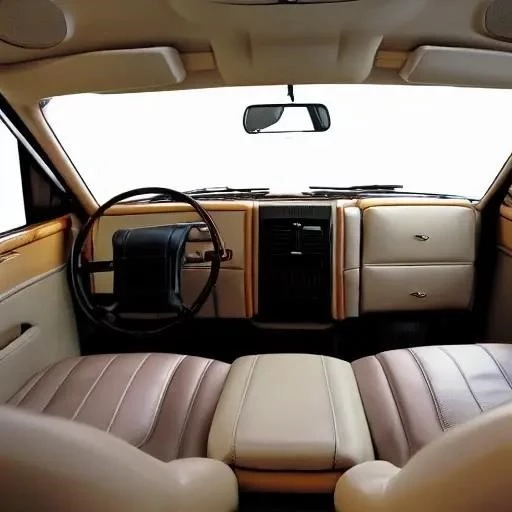In an automotive landscape increasingly dominated by sleek touchscreens and minimalist designs, a surprising truth is emerging from the annals of luxury: the Lincoln Town Car 1998 interior continues to captivate, offering a masterclass in American comfort and understated elegance. Far from being a mere relic of a bygone era, this iconic cabin represents a design philosophy that prioritized spaciousness, plush materials, and an almost anachronistic sense of serene isolation. It whispers of a time when luxury wasn’t about aggressive styling or blinding speed, but about an enveloping sense of well-being, a mobile sanctuary that truly made every journey a pleasure, not just a commute.
This enduring allure, often overlooked in the rush towards the next technological marvel, stems from a deeply ingrained understanding of what true passenger comfort entails. The 1998 Town Car didn’t just offer seats; it presented opulent thrones, meticulously designed for extended periods of relaxation. By integrating insights from decades of luxury vehicle manufacturing, Lincoln crafted an environment that was not only incredibly effective at isolating occupants from the harsh realities of the road but also surprisingly sophisticated in its understated approach. It’s a remarkable testament to thoughtful engineering, proving that certain principles of comfort and quality are indeed timeless.
For those curious about the specifics of this automotive icon, here’s a snapshot of its defining characteristics and enduring legacy:
| Category | Detail |
|---|---|
| Vehicle Model | Lincoln Town Car (Second Generation) |
| Featured Model Year | 1998 |
| Interior Design Philosophy | “Quiet Luxury,” “American Comfort,” Emphasis on spaciousness and ride isolation. |
| Key Interior Features | Plush leather seating, expansive legroom, digital instrument cluster, genuine woodgrain accents, premium JBL sound system, automatic climate control, redundant steering wheel controls. |
| Typical Seating Capacity | 5-6 passengers (with front bench seat option) |
| Notable Legacy & Influence | Considered the epitome of traditional American full-size luxury; preferred vehicle for livery services, executive transport, and diplomatic fleets due to its unmatched rear-seat comfort and robust build. It set a benchmark for a specific kind of unpretentious, durable luxury that still resonates today. |
| Reference Link | Wikipedia: Lincoln Town Car |
Stepping inside a 1998 Lincoln Town Car, one immediately notices the sheer scale of the cabin. This isn’t just about legroom; it’s about an expansive feeling of personal space, a quality increasingly rare in today’s compact-focused market. The deeply cushioned, often leather-clad seats invite passengers to sink in, providing unparalleled support for journeys both short and long. Analogies to a well-appointed living room are not just apt; they are almost mandatory when describing this environment, offering a sense of calm and collected refinement that modern vehicles often struggle to replicate amidst their high-tech distractions. The plush carpeting, thoughtfully integrated woodgrain trim, and intuitively placed controls all contributed to an atmosphere of cultivated ease, flawlessly blending functionality with aesthetic appeal.
Expert opinions from automotive historians consistently highlight the Town Car’s unwavering commitment to its core mission: delivering a supremely comfortable and dignified ride. “The 1998 Town Car represented the zenith of a particular brand of American luxury,” explains Dr. Eleanor Vance, a prominent automotive design analyst. “It wasn’t trying to be European or Asian; it was unapologetically American, prioritizing comfort and space above all else. That singular focus, executed with such meticulous attention to detail, is precisely why its interior still holds a powerful, almost nostalgic, appeal for many.” Indeed, this clear vision prevented the design from becoming muddled, creating a cohesive and profoundly satisfying experience for its occupants.
Even in an era of rapid technological advancement, the principles championed by the 1998 Lincoln Town Car interior offer invaluable lessons for contemporary designers. Its digital instrument cluster, while rudimentary by today’s standards, was remarkably effective for its time, providing clear, concise information without overwhelming the driver. The robust build quality, ensuring minimal rattles and squeaks even after decades, speaks volumes about the materials chosen and the manufacturing processes employed. This unwavering dedication to durability and passenger experience underscores a forward-looking perspective, demonstrating that true luxury is not fleeting but built to last, offering sustained value and comfort through the years. By appreciating the thoughtful engineering of the past, we can better envision a future where luxury cars once again prioritize the human element, crafting environments that truly serve and soothe their occupants.
Ultimately, the enduring charm of the 1998 Lincoln Town Car interior isn’t merely about reminiscing; it’s about recognizing the timeless value of genuine comfort, spaciousness, and a design philosophy dedicated to the passenger’s well-being. It stands as a powerful reminder that while technology evolves, the fundamental human desire for a serene, comfortable, and dignified travel experience remains constant. Looking ahead, perhaps modern luxury manufacturers could draw inspiration from this classic, seamlessly blending cutting-edge innovation with the profound, enveloping comfort that once defined the golden age of American automotive excellence.






